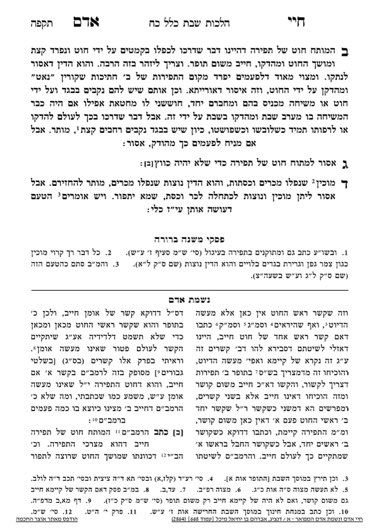We are beginning siman 3. The siman is one line, but is not so simple.
The Chayei Adam writes that it is assur to stretch out a thread so that it is not compacted. Thread can be made by wrapping it around itself, but when that is done, the thread sometimes needs to be pulled in order to untangle, straighten or lengthen it. The source for this halacha is a Rambam, and the Rambam actually holds it is an issur deoraysa. Although there is no sewing performed, the act of preparing the thread and making it easier to use is included in the melacha. It will obviously be a toldah of the melacha, but it is still hard to understand why one would be chayav in this case.
To explain, we have to understand that the Rambam follows this approach elsewhere in hilchos Shabbos, calling it tzorechei hamelacha, something part of the process of performing a melacha. Although it does not significantly contribute to the primary melacha, the Rambam holds this action itself is assur mideoraysa. He applies this approach to melabein, bishul and tzoveya, among others. For example, stirring dye in a pot, or stirring food in a pot, is considered part of tzoveya and bishul, respectively. It is not clear how far the Rambam applies this concept.
The Chayei Adam himself holds that regarding stretching out the thread, even if one does not accept the Rambam’s opinion that it is assur mideoraysa, it is still assur miderabanan.
Previously, we discussed a case of a garment coming apart, and a person pulling on the stitching in order to tighten the stitching. This understanding of the Gemara’s case is based on Rashi. Based on this approach, according to the Rambam, even if there was no thread connecting between the two pieces of garment, one will be chayav for preparing the thread that will eventually be used to connect them.
According to the Rambam, the issur of tzorchei hamelacha applies when a person wishes to prepare to perform tofeir. If one does not intend to perform tofeir, such as if they are untangling their tzitzis strings, it would be muttar (assuming there are no issues of koshair or matir).
A knot which was made unintentionally can be untied, because it does not have the status of a knot. Therefore, even undoing an unintentional knot in the tzitzis can be muttar. It also is not relevant to the concern of tofeir, as we just said, so it will be muttar to undo the unintentional tangled knot.
Summary
Certain tzorchei hamelacha, actions which are an integral part of performing a melacha, are assur in their own right. Over here, smoothing or untangling a thread in order to perform tofeir is assur in and of itself.



